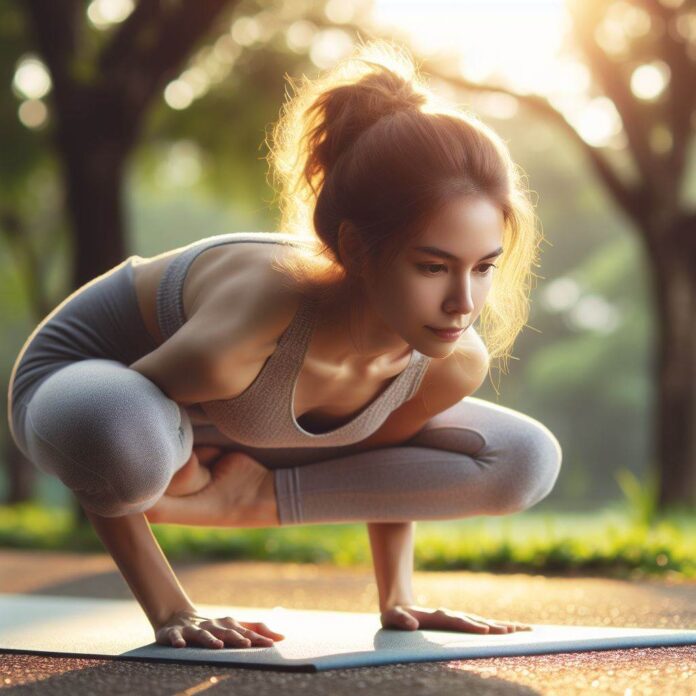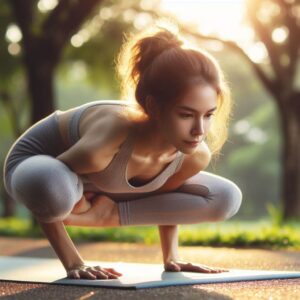Mastering yoga postures is akin to a personal odyssey, each new balance or bend a triumph of strength and inner peace. If you’re on a quest to learn one of yoga’s quintessential arm balances—Crow Pose (Bakasana)—you’re in for a rewarding experience. This milestone move can improve your core strength, balance, and mental focus. For health-conscious individuals, Crow Pose might just be the feather in their cap of a holistic fitness regimen.
In this comprehensive guide, we’ll tackle the Crow Pose journey in ten stages—breaking down everything you need to know, from foundational exercises to the final graceful perch. Whether you’re a fledgling yogi, a dedicated practitioner, or someone looking to enhance their health through yoga, this guide is your roadmap to achieving the elusive Bakasana posture.
Crow Pose
The initial step towards mastering the Crow Pose is to cultivate a strong foundation by focusing on your core strength. A robust core is the bedrock of all yoga poses, but it’s especially crucial for achieving and maintaining the balance required in arm balances like the Crow Pose. Start your practice with exercises such as plank holds, side planks, and boat poses. These exercises not only strengthen the abdominal muscles but also improve your overall stability and endurance. Committing to a daily routine that targets core strengthening will prepare your body for the demands of the Crow Pose and set the stage for a successful practice.
Once a solid core foundation has been established, the next pivotal step in your Crow Pose odyssey involves preparing your wrists for the weight they will support. Wrist strength and flexibility are essential, as the wrists bear much of your body weight in this pose. Begin with gentle wrist stretches—extending the arms forward and gently pulling back on the fingers and palms to stretch the wrists and forearms. Follow this with wrist-strengthening exercises, such as wrist curls and extensions using light weights or resistance bands. Incorporating these exercises into your routine will help prevent injury and ensure your wrists are ready for the challenges of the Crow Pose.
Step 1: Establish Your Foundations
Before levelling up to Crow Pose, a solid foundation is non-negotiable. For beginners, this means fostering upper body strength through regular push-ups, arm balances, and planks. Yoga sessions should include asanas like Chaturanga Dandasana (Four-Limbed Staff Pose) and Adho Mukha Savasana (Downward-Facing Dog Pose) to build the necessary arm and shoulder endurance.
Core stability exercises are equally important. A strong core serves as the platform to lift your bodyweight off the ground. Incorporate boat poses, bicycle crunches, and traditional planks into your routine to fortify your midsection.
Step 2: Unveiling the Essence of the Crow
Understanding the mechanics of Crow Pose is the first step to embodying it. Crow Pose requires a deep squat, a strong grip on the ground with the fingertips, and an engagement of the core as you lean forward to lift your feet. The key is to create a counterbalance between your torso and legs, utilizing strength and control to maintain the posture.
Take time to explore the nuances of Crow Pose without attempting the full expression. Practice shifting your weight onto your hands, spreading your fingers wide, and keeping your elbows bent to support your knees as you gradually lift your feet off the ground.
Step 3: The Art of Squatting
In yoga philosophy, mastering the squat is a vital milestone towards equilibrium. Yogi squats, or Malasada, are an excellent precursor to Crow Pose. Regular practice of Malasana will help improve the flexibility and strength in your ankles, knees, and hips—joints heavily involved in achieving the Crow.
Focus on maintaining an erect spine and keeping your heels grounded. You can use your elbows to gently push your knees outwards, which not only helps with balance but also mimics the arm position in Crow Pose.
Step 4: Strengthening the Wrists and Forearms
Wrist and forearm strength is often overlooked but is crucial for the integrity of arm balances. To prepare, begin with wrist circles and gentle stretches. Gradually progress to weight-bearing exercises like tabletop position, where you can practice shifting your weight back and forth.
Periodically engage in exercises specifically designed to condition the wrists, such as finger flicks and reverse wrist curls. Consistency is key, so aim for little and often in your wrist conditioning routine.
Step 5: Enhancing Flexibility and Range of Motion
A flexible body is a pliable canvas for yoga’s intricate postures. Focus on opening the hips, stretching the back, and freeing the hamstrings. Yoga asanas such as Warrior Poses, Pigeon Pose, and Forward Folds are your allies in this quest.
Incorporate hip opening stretches and dynamic movements to increase mobility. Over time, you’ll notice improvements in your range of motion, making it easier to transition into the deep squat and forward bend of Crow Pose.
Step 6: Improving Balance Through Drishti
Drishti—a focused gaze—can dramatically enhance your balance and concentration. In Crow Pose, your drishti is usually fixed on a point on the ground slightly ahead of you. This visual anchor helps to calm the mind and strengthens the connection between your mental and physical being.
In your Crow Pose preparation, practice holding challenging balances while maintaining a steady gaze. This can include one-legged poses like Tree Pose, or even practicing the one-legged Crow variation.
Step 7: Breathing for Endurance
Breath is the essence of yoga, sustaining movement and focus. Developing a regular pranayama (breath control) practice will help you maintain Crow Pose for longer durations.
In your preparation, focus on inhaling deeply into the belly and exhaling slowly through the nose. Match your breathing with the effort needed to balance in Crow—inhale deeply as you prepare to lift, and exhale to flow into the posture.
For further inspiration and to explore the age-defying fitness routines embraced by individuals who have excellently maintained their physique through their senior years, visit Age-Defying Secrets of the Amazing Ernie Hudson: A Fitness and Health Guide. This guide offers actionable insights and motivation for those looking to incorporate longevity into their fitness regime.
Step 8: Strength in Unity—Working Muscles in Crow Pose
Crow Pose is a full-body workout that predominantly engages the arms, core, back, and hip flexors. To support your practice, concentrate on exercises that target these muscle groups. Incorporate backbends like Bhujangasana (Cobra Pose) to strengthen your upper back and core, and use boat poses to target the hip flexors.
Remember that the key to Crow Pose is not just about strength—it’s also about learning to engage and work your muscles harmoniously to achieve the pose.
Step 9: Transition and Flow
To enhance your yoga practice, work on transitions and creating smooth, controlled movements. Flow yoga (Vinyasa) classes are particularly beneficial for learning how to shift from one posture to another with grace and strength. Incorporate Crow Pose into your Vinyasa sequences, practicing the transition from a low lunge or Malasana squat.
Additional Resources and Further Learning
To deepen your understanding and enhance your practice of Crow Pose (Bakasana), consider exploring these recommended resources. Each offers valuable insights and techniques to support your yoga journey:
- Yoga Journal: An extensive library of postures with step-by-step instructions, including modifications for Crow Pose. Visit Yoga Journal
- Yoga with Adriene: A variety of free, high-quality yoga videos for all levels, including tutorials on arm balances. Watch on YouTube
- Glo: Offers guided classes from world-renowned yoga instructors, focusing on building strength and flexibility for arm balances. Explore Glo
- Leveraging these resources can bolster your technique, understanding, and appreciation of not just Crow Pose but yoga as a holistic practice.
- Yoga with Adriene: A variety of free, high-quality yoga videos for all levels, including tutorials on arm balances. Watch on YouTube
Step 10: Honing Your Crow—Advanced Techniques
Once you’ve become comfortable with Crow Pose, you can start to explore variations and deepen the posture. Try extending one leg at a time, or transitioning from Crow Pose into a high plank position and back. Advanced practitioners can even work on ‘shooting’ back into Chaturanga from Crow Pose—though this requires significant upper body strength and control.
Always listen to your body and progress at your own pace. Yoga is a deeply personal practice, and the true mastery lies in your willingness to learn and grow with each session.
In conclusion, the Crow Pose is not just a feat of physical prowess—it’s a testament to your dedication and mindfulness. Every step of the journey takes you closer to a deeper understanding of your body’s capabilities. Start your Batasan odyssey today, and celebrate each incremental success towards balancing on wings of your own making.



